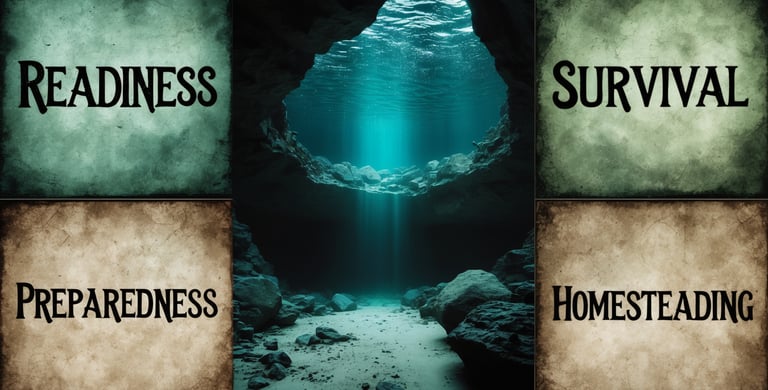Preparedness: Water Preparedness
Storage, Purification, and Renewable Access Strategies
4FORTITUDER - READINESS, SURVIVAL, PREPAREDNESS, HOMESTEADING
Preparedness: Water Preparedness
Storage, Purification, and Renewable Access Strategies
“Thousands have lived without love, not one without water.”
— W. H. Auden
Water Is Life—But Only If It’s Accessible, Potable, and Secure
In any disaster, water fails first. It is the most overlooked and underestimated form of preparedness. The shelves will empty. The pipes will shut. The taps will rust. And if you haven’t planned beyond a few plastic jugs, you will dehydrate faster than your discipline can react.
Water preparedness is not just about storage. It’s about sourcing, purifying, conserving, and rotating water under pressure—all while maintaining dignity, hygiene, and strength.
The rule is simple: 3 days without water and your body begins to collapse. And in most emergencies, water becomes scarce in less than 24 hours.
Core Knowledge Foundation: The Four Pillars of Water Preparedness
Short-Term Storage – Readily accessible, portable reserves.
Long-Term Storage – Stationary, high-volume, rotated supply.
Purification Methods – Multiple ways to make unknown sources drinkable.
Renewable Water Sources – Catchment, retrieval, filtration, and reclamation.
Misconception Warning: Boiling water kills germs, yes—but it doesn’t remove chemicals, heavy metals, or long-term pathogens. Method matters.
1. Short-Term Water Storage
Goal: 72 hours of immediate, portable hydration for every person in your household.
How to Prepare:
Store 1 gallon per person per day minimum
(2 gallons per day if you include hygiene and cooking)Use sealed gallon jugs, 5-gallon jerry cans, or bottled water cases
Place in: closets, vehicles, under beds, garages
Best Practice:
Rotate store-bought water every 6 months (or by printed expiration)
Label tap-filled containers with date and sanitize before refilling
Drill: Go 48 hours using only your short-term water cache. No tap. Track how much you used for drinking, cooking, cleaning. Adjust cache based on outcome.
2. Long-Term Water Storage
Goal: Weeks or months of clean water, safely stored and easily accessed.
How to Prepare:
50–100 gallon drums (BPA-free, food-grade plastic)
IBC totes for 275–330 gallon reserves
Water bricks (stackable 3.5-gallon blocks)
Preparation Process:
Clean container: use unscented bleach + rinse thoroughly
Fill with tap water treated with 1/8 tsp of household bleach per gallon
Store in dark, cool, pest-free area
Rotate annually, even if unused
Extras:
Manual siphon pump
Water-safe hose for fill and draw
Covered access point to prevent contamination
Drill: Simulate a 7-day water outage. Use only long-term stored water. Practice siphoning, rationing, and sanitizing.
3. Purification Methods – Redundancy Required
Goal: Treat suspect or natural water to make it safe for consumption.
Four Layers of Purification:
Mechanical Filtration
Removes sediment
Tools: coffee filters, cloth, sand-gravel DIY filters
Biological Filtration
Removes bacteria, protozoa
Tools: Sawyer Mini, LifeStraw, Berkey, gravity bag filters
Chemical Treatment
Kills bacteria/viruses
Tools: chlorine dioxide tablets, bleach (8 drops per gallon), iodine tincture
Heat Treatment
Boiling: full rolling boil for 3+ minutes (5,000+ ft elevation = 5 min)
Golden Rule: Combine methods. Filter + boil or filter + chemical = best practice.
Drill: Gather 1L from a natural source. Purify it using two methods. Taste, compare, and journal effectiveness and ease of use.
4. Renewable Water Sources
Goal: Access new water when stored supply runs out.
Rainwater Catchment:
Roof gutters → first flush diverter → storage barrel
Mesh screens to block debris/insects
Always filter + purify before use
Groundwater:
Manual well pump (if land allows)
Spring identification (follow animal trails, moss-rich areas)
Greywater Reuse (Non-potable):
Dishwater for flushing
Shower runoff for gardening
Reclaim humidity with DIY condensation stills
Drill: Build a basic rain catchment system using tarp + bucket + mesh. Simulate one rainfall. Log gallons collected per hour.
Advanced Insights: The Psychological and Social Cost of Water Loss
Water failure doesn’t just affect hydration—it breaks morale.
No coffee, tea, or warmth = lower mood
No hygiene = disease + demoralization
No toilets = breakdown of dignity, routine, privacy
Historical Anchor: Flint, Michigan Water Crisis (2014–2019)
Families unable to drink from their taps for years. Social trust collapsed. Health deteriorated. Government failed—and the prepared survived.
Those with stored water, filters, and contingency plans didn’t suffer. They led.
Critical Perspectives: The Myth of Infinite Water Access
Adversarial Viewpoint:
“Water is always available. Cities have filtration systems. Lakes are everywhere. This is fear-mongering.”
Response:
Access is not the same as availability. Clean water is fragile. Municipal pipes break. Contamination spreads. Heatwaves dry sources. If you don’t control your own water, you’re one decision away from dehydration.
Wisdom and Warning Duality
When Followed: You drink calmly while others boil puddles. Your family stays clean, nourished, strong.
When Ignored: You barter for water at gunpoint. You risk infection, collapse, or worse—watch your family thirst because you thought rain would always fall.
Strategic Crossroad: Will you master water logistics now—or surrender to thirst later?
Final Charge & Implementation
Brother, water isn’t optional. It is life in liquid form. When systems crack—and they will—the man who controls clean water becomes a leader, not a liability.
Start Now:
Build the 4-Layer Water Plan
“Prepare for the drought in the days of rain.”
Short-term cache (3 days)
Long-term storage (30+ days)
Purification redundancy (3+ tools)
Renewable capture/reuse systems
Establish the Monthly Water Ritual
“Discipline drinks before thirst arrives.”
Inspect storage for leaks
Rotate expiring supplies
Practice one purification method
Rehearse one no-tap day each month
Strategic Reflection:
If the water shut off tonight, could you hydrate, wash, and cook for 7 days—with no help?
Existential Challenge:
When your children say, “I’m thirsty,” will you have to ration their survival?
Control the flow. Master the cycles. And never be caught dry again.
“The prepared man doesn’t find water—he becomes the one others turn to when the rivers run dry.”


